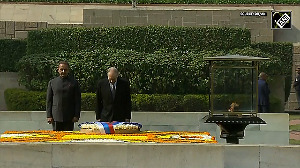By choosing your study destination carefully, leveraging government schemes, comparing loan options, and adopting frugal living practices, Indian students can acquire global credentials without mortgaging their futures, says Prashant A Bhonsle

Studying abroad is one of those dreams that feels both exciting and little scary. Imagine stepping off a plane in a new country, ready to dive into a top-notch education, meet people from all over the world, and maybe even pick up a new language or two.
For many Indian students, it's a golden opportunity to grow and see the world. But here's the catch -- it's not cheap.
In 2024 alone, over 750,000 Indian students headed overseas for their studies. That's a massive number, but it's actually down from the year before.
Why? Situations like tougher visa rules, a weaker rupee, and rising costs have made students rethink their plans.
The good news, however, is that you can still make this dream work without ending up buried in debt.
Fluctuating Trends in Global Student Mobility
The post-pandemic surge in Indian students studying abroad peaked in 2023 with 890,000 enrollments. Traditional destinations like the US and Canada saw significant declines, 11% and 41% respectively, due to stricter visa policies and the rupee's depreciation against the dollar making it costlier for Indian students to study abroad.
At the same time, a different cohort of countries gained traction. Enrollments in Russia surged by 34%, while Germany and France saw increases of 49% and 14%, respectively.
These shifts highlight students' growing preference for cost-effective destinations with streamlined post-study work opportunities.
The Multilayered Cost of Global Education
Studying abroad involves far more than tuition fees. In the US, annual living expenses range from $10,000 to $25,000, with accommodation alone costing $9,800 to $11,100. Indian students in the UK spend Rs 1.5-2.3 lakh monthly on essentials, while those in Australia allocate Rs 24,500 to Rs 60,500 monthly for housing.
Pre-departure costs add another layer to an already complicated situation.
Visa fees average Rs 29,300 for the US, while standardised tests like GRE and IELTS cost Rs 22,500 to Rs 80,000, and airfare often exceeds Rs 100,000. These figures underscore the need for holistic budgeting, as overlooked expenses can derail financial plans.
Government Initiatives Easing the Burden
To mitigate these costs, India's PM-Vidyalaxmi Scheme offers collateral-free loans up to Rs 750,000 with a 75% credit guarantee and 3% interest subvention for families earning under Rs 800,000 annually. On the other hand, the Fulbright-Nehru Fellowships provide comprehensive support, covering tuition, airfare, and living expenses for master's and doctoral candidates.
These programmes, coupled with university-specific scholarships, reduce reliance on high-interest loans. However, awareness remains low, with many students overlooking opportunities like the National Overseas Scholarship for marginalised communities.
Banking Solutions and Loan Dynamics
Education loans remain a cornerstone of studying abroad. Public-sector banks often offer loans at competitive interest rates. However, the extensive documentation requirements create major barriers for students.
Non-banking financial companies (NBFCs) bypass these bureaucratic bottlenecks through easy and accessible digitised processes.
Loans can be applied for through digital portals, with decisions on eligibility and approvals made within a few hours. This agility stems from NBFCs' focus on analysing university rankings and post-graduation salary projections instead of physical asset appraisals.
Strategic Financial Planning for Long-Term Stability
Avoiding debt requires proactive measures.
- Students should prioritise destinations with lower living costs, such as Germany, where annual expenses average Rs 9 lakh to Rs 12 lakh.
- Building an emergency fund covering 3 to 6 months of expenses is also important, since health insurance and unexpected costs can strain budgets.
- Currency hedging strategies, such as locking in exchange rates, mitigate risks from rupee volatility.
- Apart from this, part-time work can supplement income without compromising academic commitments.
The path to international education is fraught with financial complexities, but strategic planning transforms aspirations into achievable goals.
By choosing your study destination carefully, leveraging government schemes, comparing loan options, and adopting frugal living practices, Indian students can acquire global credentials without mortgaging their futures.
Adaptability and informed decision-making remain keys to successfully completing this journey.
Prashant A Bhonsle is the founder and CEO, Kuhoo Technology.










